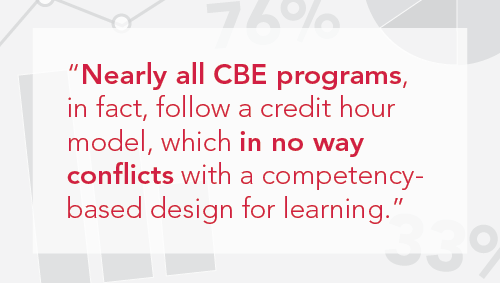At a time when higher education is actively experimenting with competency-based education (CBE), confusion abounds about what CBE is and the extent of its contribution to the present transformation of higher education. As part of our ongoing coverage of the CBE marketplace, Eduventures has spoken with over 300 higher education industry leaders about this practice. Part of our goal was to better understand myths and misconceptions about CBE, of which there are many.
Here are five of the most common myths and misconceptions we heard:


- CBE is just a fad. Actually, this could not be further from the truth. As a distinct program format, CBE has steadily matured for well over 40 years into a market that Eduventures now estimates consists of about 150 institutions enrolling 200,000 students. CBE also builds on hundreds of years of complementary advancements in teaching and learning, from apprenticeships, mentor-based learning, and vocational training to extension and continuing education, workforce training, and online learning. These movements have always been focused on competency. CBE just extends these efforts into a new era of teaching and learning.
- CBE is not for everyone. Along these same lines, CBE is commonly seen as a unique approach to teaching and learning that not all institutions will pursue. This is plausible but narrow-sighted. Good education, after all, has always been “based” on alignment with some notion of “competency.” Assuming the goal of education is to prepare students for success in particular subjects, jobs, or fields through advanced study in a discipline, any institution committed to student success should also be committed to CBE.

- CBE is about skills, not abstract knowledge. CBE is often characterized as nothing more than skills-based training, which is a myopic viewpoint. While it is indeed practical in nature, CBE can (and should) also focus the exploration of ideas, theories, and concepts, provided that what students encounter is also applied in a professional, academic, or personal context. In essence, CBE is not only about skills, but also about the application of skills against the backdrop of deep knowledge. This process is enhanced by complementary notions, such as applied theory, engaged scholarship, or evidence-based learning, which themselves are competency-based in nature.
- CBE is only for adult learners. Although CBE has historically taken root mostly among adult-serving institutions, such as completion colleges and online schools, this is hardly the extent of this market. Many types of institutions today are experimenting with CBE for traditional-age learners. This may include institutions and schools that incorporate pedagogic concepts like project-based learning, scenario-based training, and adaptive instruction, all of which are competency-based by design and no less conversant with some of the same principles and practices that inform adult-serving programs (e.g., self-directed learning). This may also include institutions training undergraduates for careers in STEM and other technical disciplines. These types of programs have always been competency-based.

- CBE means uncoupling from the credit hour. Commonly, CBE is described as prioritizing learning over time spent in a classroom. While accurate, this description seems to suggest that CBE is somehow in conflict with conventional time-bound measures of learning, such as the credit hour (or Carnegie Unit), which is not true. Nearly all CBE programs, in fact, follow a credit hour model, which in no way conflicts with a competency-based design for learning. CBE institutions, for instance, may opt simply to map competencies to credit hours through a process called credit hour equivalency. Alternatively, they may simply incorporate the principles and practices of CBE into an otherwise wholly time-bound, credit-bearing program, often through a process called outcomes-based course design. Either approach allows for experimentation with CBE without ever having to navigate the cultural, regulatory, and technical hurdles that come with uncoupling from the credit hour.

